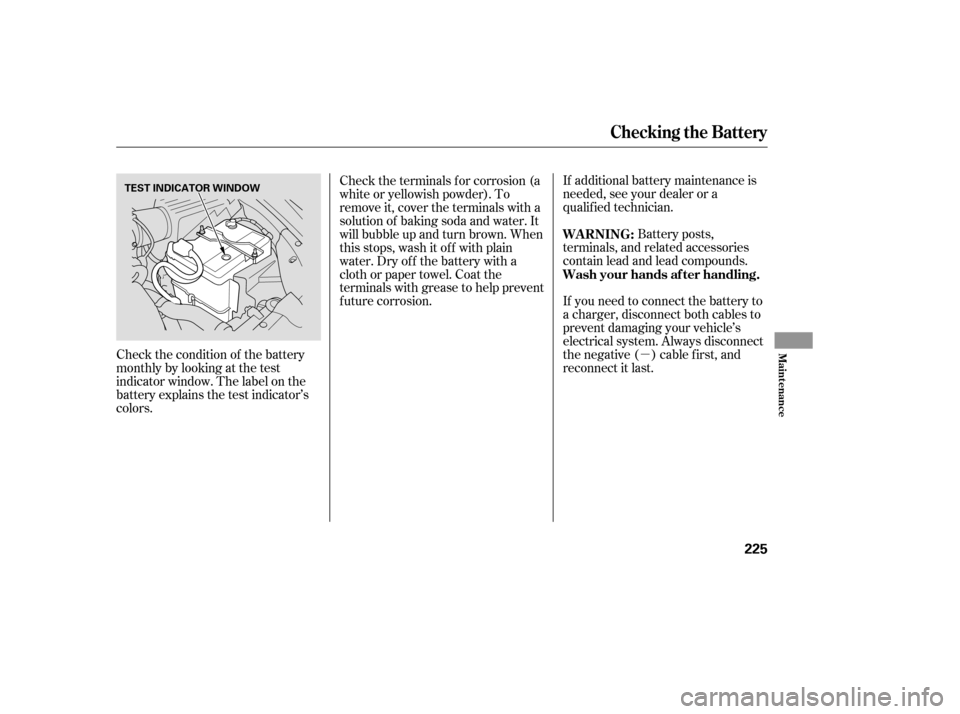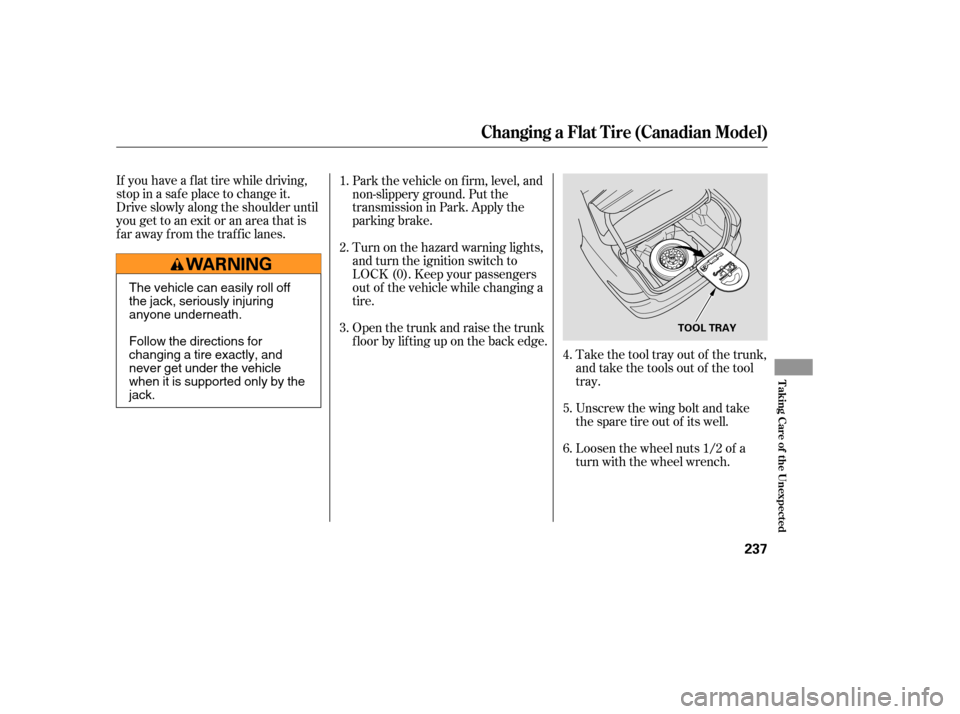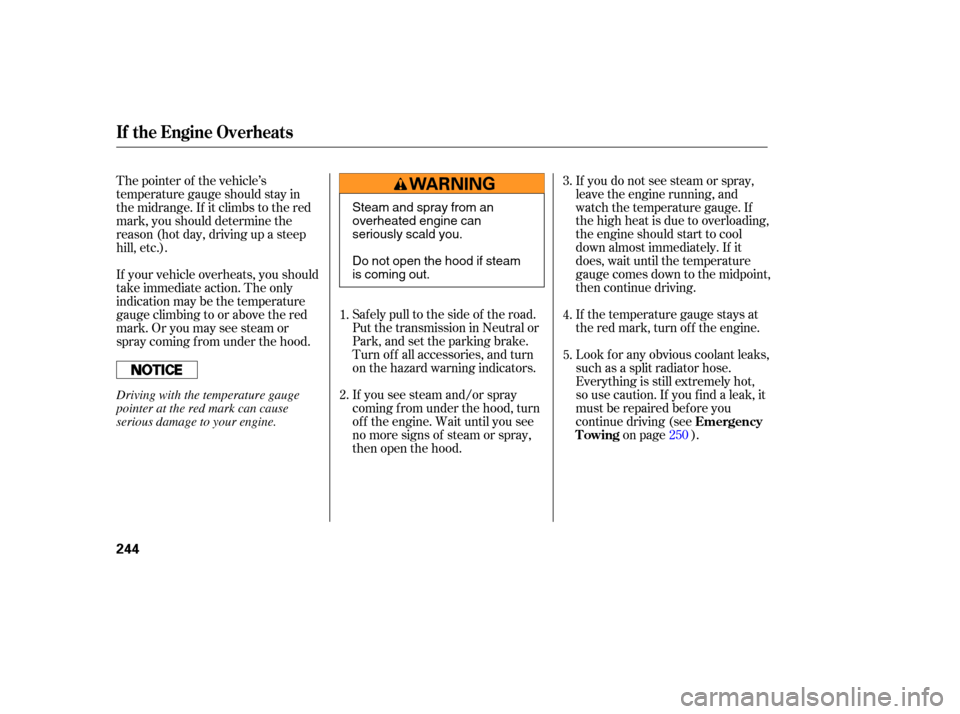Page 71 of 286
�Î
�ÎOnly on vehicles equipped with navigation system. Ref er to the navigation system manual.
:
Controls Near the Steering Wheel
70
WINDSHIELD
WIPERS/WASHERS
INSTRUMENT PANEL
BRIGHTNESS
VOICE CONTROL
SWITCHES HEADLIGHTS/
TURN SIGNALS
REMOTE AUDIO
CONTROLS
TRACTION CONTROL SYSTEM HORN STEERING WHEEL
ADJUSTMENT CRUISE CONTROLS
REAR WINDOW
DEFOGGER
HAZARD
WARNING BUTTON
(P.74)
(P.71)
(P.142)
(P.76)
(P.179)
(P.138)
(P.72)
(P.75,103,106)
(P.75)
�����—���
�—�����y�
����
��������y���
�(���'�������y���������y
Page 76 of 286
Bef ore driving, make sure the rear
window is clear.
The rear window is equipped with
def ogger wires. The wires are
attached from inside the vehicle. To
clean the rear window, wipe it from
side to side to prevent the wires f rom
being damaged.
Turn on this def ogger to def og or
de-ice the rear window. The
indicatoronthebuttonisonwhen
the def ogger is on. The def ogger
turns of f when you turn of f the
engine.
Press the hazard warning button if
you need to bring your vehicle to an
emergency stop, or if it is disabled.
When you press the button, the turn
signal lights and the turn signal
indicators blink.
Hazard Warning, Rear Window Def ogger
Rear Window Def ogger
Hazard Warning
Inst rument s and Cont rols
75
HAZARD WARNING BUTTON
�����—���
�—�����y�
����
��������y���
�(���'�������y���������y
Page 87 of 286

�µ
See pages f or important saf ety
inf ormation and warnings about how toproperly position seats and seat-backs. 14
13
The controls f or the adjustable
driver’s power seat are on the
outside edge of the seat bottom. You
can adjust the power seat with the
ignition switch in any position. Make
all seat adjustments bef ore you start
driving.
Moving the long horizontal switch
adjusts the seat bottom in several
directions. The seat bottom adjusts
in the direction you move the switch.
The short vertical switch adjusts the
seat back angle.
In HI, the heater turns of f when the
seat gets warm, and turns back on
after the seat temperature drops.
In LO, the heater runs continuously.
It does not cycle with temperature
changes.
Follow these precautions whenever
you use the seat heaters:
Use the HI setting only to heat the
seats quickly, because it draws
large amounts of current f rom the
battery.
If the engine is lef t idling f or an
extended period, do not use the
seat heaters even on the LO
setting. It can weaken the battery,
causing hard starting.
Both f ront seats are equipped with
seat heaters. Because of the sensors
f or the side airbag system, there is
no heater in the passenger’s seat-
back. The ignition switch must be
ON (II) to use the heaters.
After the seat reaches a comfortable
temperature, select LO by pushing
the back of the switch. This will keep
the seat warm.
Seat Heaters, Seats
Adjusting the Driver’s Seat
Seat Heaters
86
�����—���
�—�����y�
����
��������y���
�(���'�������y���������y
Page 89 of 286
To change the seat-back angle, pull
up on the lever on the outside of the
seat bottom.Your vehicle is equipped with head
restraints in all seating positions to
help protect you and your
passengers f rom whiplash and other
injuries.They are most ef f ective when you
adjust them so the back of the
occupant’s head rests against the
center of the restraint.
The f ront and rear head restraints
adjust f or height. You need both
hands to adjust the restraint. Do not
attempt to adjust it while driving. To
raise it, pull upward. To lower the
restraint, push the release button
and push the restraint down.See page f or important saf ety
inf ormation and a warning about how toproperly position the head restraints. 15
Seats
Head Restraints
88
RELEASE BUTTON
�����—���
�—�����y�
����
��������y���
�(���'�������y�������
�y
Page 226 of 286

�µ
Check the condition of the battery
monthlybylookingatthetest
indicator window. The label on the
battery explains the test indicator’s
colors. If additional battery maintenance is
needed, see your dealer or a
qualif ied technician.
Battery posts,
terminals, and related accessories
contain lead and lead compounds.
If you need to connect the battery to
a charger, disconnect both cables to
prevent damaging your vehicle’s
electrical system. Always disconnect
the negative ( ) cable first, and
reconnect it last.
Check the terminals f or corrosion (a
white or yellowish powder). To
remove it, cover the terminals with a
solution of baking soda and water. It
will bubble up and turn brown. When
this stops, wash it of f with plain
water. Dry off the battery with a
cloth or paper towel. Coat the
terminals with grease to help prevent
f uture corrosion.
WARNING:
Wash your hands af ter handling.
Checking the Battery
Maint enance
225
TEST INDICATOR WINDOW
�����—�
���—���
�y���������������y���
�(���'�������y���������y
Page 238 of 286

If you have a f lat tire while driving,
stop in a saf e place to change it.
Drive slowly along the shoulder until
you get to an exit or an area that is
far away from the traffic lanes.Loosen the wheel nuts 1/2 of a
turn with the wheel wrench. Unscrew the wing bolt and take
the spare tire out of its well. Take the tool tray out of the trunk,
and take the tools out of the tool
tray.
Park the vehicle on f irm, level, and
non-slippery ground. Put the
transmission in Park. Apply the
parking brake.
Turn on the hazard warning lights,
and turn the ignition switch to
LOCK (0). Keep your passengers
out of the vehicle while changing a
tire.
Open the trunk and raise the trunk
f loor by lif ting up on the back edge.
5. 4.
3. 2. 1.
6.
Changing a Flat Tire (Canadian Model)
T aking Care of t he Unexpect ed
237
TOOL TRAY
The vehicle can easily roll off
the jack, seriously injuring
anyone underneath.
Follow the directions for
changing a tire exactly, and
never get under the vehicle
when it is supported only by the
jack.
�����—�
���—���
�y��������
������y���
�(���'�������y���������y
Page 245 of 286

Saf ely pull to the side of the road.
Put the transmission in Neutral or
Park, and set the parking brake.
Turn of f all accessories, and turn
on the hazard warning indicators.
If you see steam and/or spray
coming f rom under the hood, turn
of f the engine. Wait until you see
no more signs of steam or spray,
then open the hood.If you do not see steam or spray,
leave the engine running, and
watch the temperature gauge. If
the high heat is due to overloading,
the engine should start to cool
down almost immediately. If it
does, wait until the temperature
gauge comes down to the midpoint,
then continue driving.
If the temperature gauge stays at
the red mark, turn off the engine.
Look f or any obvious coolant leaks,
such as a split radiator hose.
Everything is still extremely hot,
so use caution. If you f ind a leak, it
must be repaired bef ore you
continue driving (see
on page ).
The pointer of the vehicle’s
temperature gauge should stay in
the midrange. If it climbs to the red
mark, you should determine the
reason (hot day, driving up a steep
hill, etc.).
If your vehicle overheats, you should
take immediate action. The only
indication may be the temperature
gauge climbing to or above the red
mark. Or you may see steam or
spray coming f rom under the hood.
1.
2.3.
4.
5.
250Emergency
Towing
If theEngineOverheats
244
Steam and spray from an
overheated engine can
seriously scald you.
Do not open the hood if steam
is coming out.
Driving with the temperature gauge
pointer at the red mark can cause
serious damage to your engine.
�����—�
���—���
�y�����������
�
�y���
�(���'�������y���������y
Page 247 of 286

Start the engine and watch the oil
pressure indicator. If it does not go
outwithin10seconds,turnoff the
engine. There is a mechanical
problem that needs to be repaired
bef ore you can continue driving
(seeon page
).
This indicator should never come on
when the engine is running. If it
starts flashing or stays on, the oil
pressure has dropped very low or
lost pressure. Serious engine
damage is possible and you should
take immediate action. If necessary, add oil to bring the
level back to the full mark on the
dipstick (see page ). Let the vehicle sit f or a minute.
Open the hood, and check the oil
level (see page ). An engine
very low on oil can lose pressure
during cornering and other driving
maneuvers. Saf ely pull of f the road, and shut
of f the engine. Turn on the hazard
warning indicators.
1.
2.
3. 4.
155 201 250
Emergency T owing
L ow Oil Pressure Indicator
246
LOW OIL PRESSURE INDICATOR
Running the engine with low oil
pressure can cause serious mechanical
damage almost immediately. Turn of f
the engine as soon as you can saf ely get
the vehicle stopped.
�����—�
���—���
�y���������������y���
�(���'�������y���������y